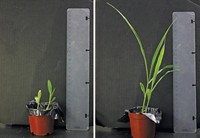Advertisement
Grab your lab coat. Let's get started
Welcome!
Welcome!
Create an account below to get 6 C&EN articles per month, receive newsletters and more - all free.
It seems this is your first time logging in online. Please enter the following information to continue.
As an ACS member you automatically get access to this site. All we need is few more details to create your reading experience.
Not you? Sign in with a different account.
Not you? Sign in with a different account.
ERROR 1
ERROR 1
ERROR 2
ERROR 2
ERROR 2
ERROR 2
ERROR 2
Password and Confirm password must match.
If you have an ACS member number, please enter it here so we can link this account to your membership. (optional)
ERROR 2
ACS values your privacy. By submitting your information, you are gaining access to C&EN and subscribing to our weekly newsletter. We use the information you provide to make your reading experience better, and we will never sell your data to third party members.
Environment
Treated wastewater sludge still harbors antibiotic resistance genes
ACS Meeting News: Findings raise public health concerns because sludge is often spread on farmlands
by Cheryl Hogue
August 22, 2017
| A version of this story appeared in
Volume 95, Issue 34

To kill microorganisms that can potentially cause disease, the world’s most advanced sewage treatment plants essentially pressure-cook wastewater. But new research indicates that this process may not get rid of genes that impart antibiotic resistance to microbes.
Because treated sludge is regularly spread on lands used to grow crops for human consumption, this finding could have public health implications, said Sarah Fischer, an environmental chemist at the University of Maryland, College Park, during a talk at the American Chemical Society national meeting in Washington, D.C. on Sunday.
The U.S. Environmental Protection Agency estimates that more than 7 million metric tons of biosolids—the residue from wastewater treatment, also called sludge—is applied to U.S. lands each year as fertilizer. Increasingly, organic farms are using manure and biosolids instead of synthetic fertilizers on food crops, pointed out Mustafa Selim of East Carolina University’s Brody School of Medicine, who co-organized the symposium.
Fischer is part of a team that is studying antibiotic resistance at an advanced wastewater treatment plant in the U.S. This facility’s thermal hydrolysis units heat wastewater to 180 °C under pressure to reduce fecal coliform, a collection of microbes that EPA regulates in wastewater discharges.
“It’s like an autoclave for sludge,” Fischer said.
After the heat-and-pressure treatment, the residue undergoes anaerobic digestion, in which microbes break down organic material for 22 days before the remaining biosolids are hauled out of the facility.
Fischer and colleagues checked materials moving along the treatment process for the presence of seven known genes that provide resistance to antibiotics. They found that thermal hydrolysis greatly reduced the presence of active, pathogenic bacteria and of the resistance genes. But after the anaerobic digestion step, the levels of the genes increased.
The research team has two hypotheses on why this is happening, Fischer continued. One is that the thermal treatment process doesn’t destroy genetic material, leaving DNA that surviving organisms can take up directly from their environment, which many bacteria can do. The other hypothesis focuses on sludge that is added to wastewater in anaerobic digesters. This material contains active bacteria that could carry the antibiotic resistance genes, thus reintroducing the genetic material to the heat-treated wastewater, she said.
The researchers are next exploring whether the antibiotic resistance genes in the treated sludge persist in agricultural fields, Fischer told C&EN. “The long term survival of the genes has been shown to decay in agricultural settings,” she adds.





Join the conversation
Contact the reporter
Submit a Letter to the Editor for publication
Engage with us on Twitter